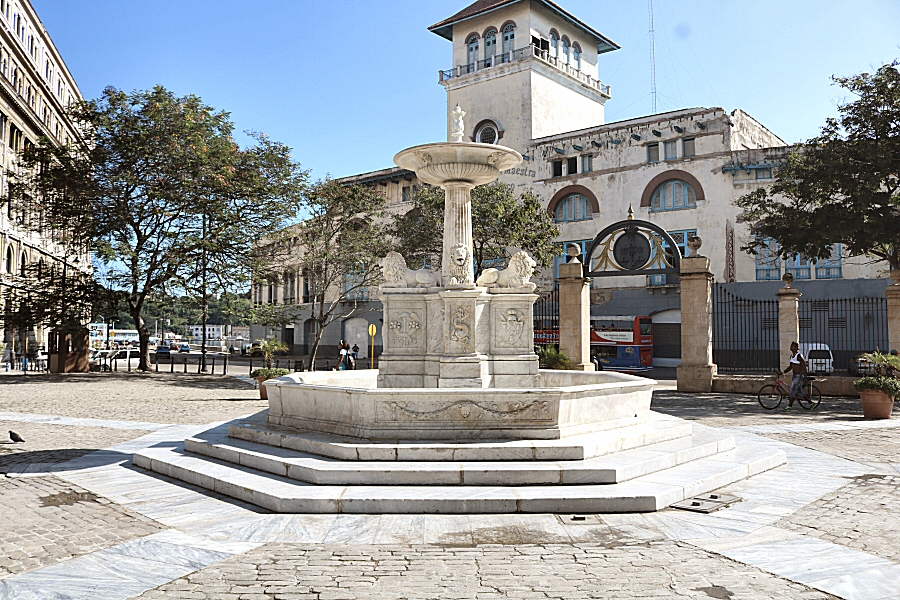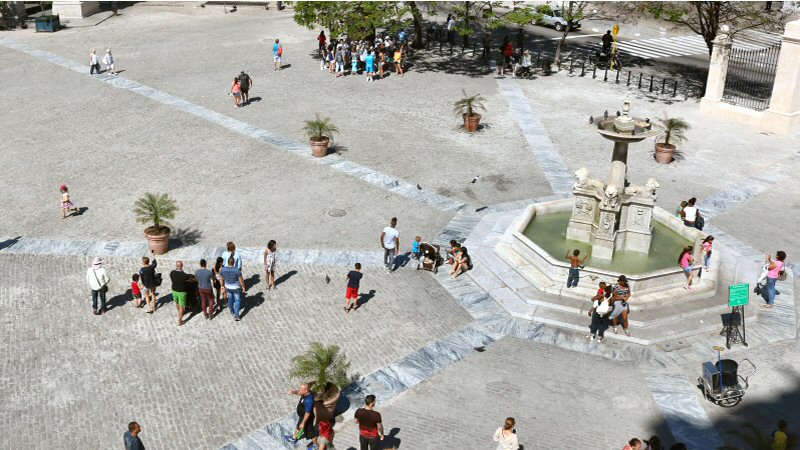
THE ORNAMENTS OF THE SQUARE : THE FOUNTAIN AND THE STATUES
Fuente de los Leones (Fountain of the Lions)
In 1836, the nice cobbled square was enriched by the Fuente de los Leones (Fountain of the Lions) that is reminiscent of the Fountain of Lions in Alhambra in Spain. It is the work of the Italian sculptor Giuseppe Gaggini that built also the Fuente de la India that stands about 100 meters south of the Capitol. Both the fountains were erected by the initiative of Claudio Martínez de Pinillos y Ceballos, the second Count of Villanueva, that was the leader of the group of sugar planters, supporting the reformist trend in Cuba in the 19th century. Giuseppe Gaggini took into account the designs prepared by Colonel Manuel Pastor in Cuba.

In fact,
the whole square is reminiscent of the typical piazza with
the central fountain in Italian towns. The fountain is made
of white Carrara marble, brought from Italy. It is composed
of a central column, supported by four lions, resting on
pedals at each corner. The water pours from the corolla at
the top of the central column and from the mouths of the
lions that have abundant, curly hairs. Currently the
fountain is located a little bit more to the southwest of
its original site. Its localization was changed, because
there was a great risk of being damaged accidentally by the
rattling of the vehicles and the people around. In 20th
century, it was moved first to the Trillo Park, then to
Alameda de Isabel II (today Paseo de Martí) and as last to
the Parque de Fraternidad, where it stayed until it returned
to the Plaza de San Francisco. Unlike the fountain in the
Plaza Vieja, this fountain is not fenced off.
In
course of the time, some notable modern art pieces were
added to the plaza, such as the bronze statue of the
composer Chopin. The statue demonstrates the peaceful Polish
composer resting on a bench. It is located just in front of
the Palacio del Marqués de San Felipe y Santiago de Bejucal.
It is the work of the famous Polish sculptor Adam Myjak that
copied Chopin’s face from the drawings, made in the last
years of his life and from the only known photo of him that
had been taken three years before his death. Although Chopin
was represented in the last stage of his life when he was
already ill, note his ambition reflected by the long
pianist’s fingers of the right hand splayed in a gesture, as
if he is playing a phrase that he has captured.
Maybe
the most attractive feature of the plaza for the tourists is
the life-size statue of the famous tramp José María López
Lledín that was known as El Caballero de Paris (the
Gentleman of Paris). This Spanish man arrived in Cuba in
1913, when he was 12 years old, and worked at different
jobs. Despite many explanations, it is unknown, how he got
this title El Caballero de Paris. It is said that he lost
his mind, when he was arrested in 1920s and sent to the
prison in El Castillo del Principe. The reason of his arrest
is unknown, but he always argued that he was innocent in
that case. He became popular by his ramblings here and there
through the streets of Havana in a dress of French style.
Soon he was arrested again, bathed and his hairs were shaved
completely, but the reaction of the public led the
authorities to release him immediately. The sympathy that
the inhabitants showed for him, influenced the President
also, so that he ordered to discharge him from the Mazorra
(Hospital Psiquiátrico de La Habana Comandante Doctor
Eduardo Bernabé Ordaz Ducunge) when he was interned in 1941.
He was diagnosed as suffering from paraphrenia. He died in
1985, after 4 years of hospitalization in the same
psychiatry clinics. To honor his memory, a bronze sculpture
was erected on the side of the main entrance to the Iglesia
y Convento de San Francisco de Asís in 2001. It is the work
of the Cuban artist José Villa Soberón that is known
particularly for his public sculptures in Havana, such as
the statues of Ernest Hemingway (in Floridita bar), Mother
Teresa of Calcutta (in Jardín Madre Teresa de Calcutta), Che
Guevara (in Palacio Central de Pioneros Ernesto Che Guevara,
Parque Lenin), and John Lennon (in John Lennon Park). The
statue of El Caballero de Paris serves as a background
object for the tourists that want to take photos with.
Over the years the statue’s beard and forefinger have been
polished by the hands of the tourists that believe that this
ritual brings luck.
At the northwest corner of the square where the Oficios street blends with the Baratillo street, stands a granite sculpture in the form of a tower, called El Cruceiro (the Stone Cross). The seven and a half meters high sculpture is the work of the master stonemason Enrique Velazco. At the beginning of the 21st century it was brought from Galicia to the Plaza de San Francisco as the donation of Manuel Fraga Iribarne, President of the Junta de Galicia, to Cuba. It serves as homage and remembrance to the Galicians that arrived at this port and entered Havana through these streets, where they later formed a family and stayed in the island forever.
The Cruceiro, is one of the most significant elements of the Galician iconography, composed of a stone cross that marks the crossroads of the roads. They can also be seen in the atriums of churches. They are distributed in different areas of the Iberian Peninsula, attributing themselves to the Christianization of places of uncertainty and to bless the roads. They are composed basically of three parts: base, rod and cross. The place where it stands today, there was a bus stop. After the restoration works in the Plaza de San Francisco, the streets were closed to the traffic and with the new pavement the Cruceiro was built at the intersection of the Oficios and the Lamparilla streets.
La Conversación (the Conversation)
The
square’s newest sculpture La Conversación was added to the
square in 2012. This modernist bronze statue stands in front
of the Lonja del Comercio and depicts two abstract figures
sitting down for a talk. It was the work of the French
artist Etienne Pirot. It was donated by the French
ambassador as a gesture of Franco-Cuban friendship.
